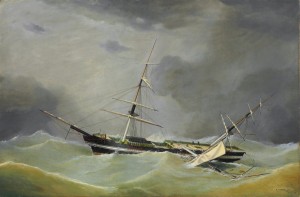If a ship was a living thing for lascars, was it always conceived of in the feminine, as was the case with European sailors? It is impossible to know of course, but I suspect not.

The word for dismasted, for example, is ‘lundbund’, which means literally ‘phallus-tied’ or ‘dismembered’, a locution that would make sense only if the mast were – at some register of speech – figured as a phallus.
Roebuck’s own gloss on this is very odd: he speculates that the term ‘lundbund’ comes from ‘nunga-moonunga’, meaning stark naked, which suggests that he was either overcome by an attack of pre-victorian prurience, or that he did not know what the word ‘lund’ meant (this is not impossible, since it is a common Indian trick to mislead foreigners about the meaning of such words. I must admit that I too am a sinner in this regard: once, in my salad days in Delhi, I was in a bazar with an English friend who was just beginning to learn Hindi. He spotted a brass lota, and having decided to buy it, wanted to know what it was called.

I confess, gentle reader, that I misled him … I will never forget the look on the shopkeeper’s face when my friend inquired about the price of his —-).
The word for ‘command’ in Laskari – which came to be used widely in English too – was ‘hookum’. Some of these provide interesting insights into the nature of the relations between lascars and their malums. For example, Roebuck translates the hookum ‘Heave and rally!’ as ‘Hubes mera bap!’ [lit: ‘heave my father] and goes on to add that “sometimes a little abuse is necessary; as for instance ‘hubes sâlâ! buhan chod hubes! (properly buhin chod hubes) or ‘hubes huramzadu!’.”[i]
So far as the grammar of Laskari is concerned, Roebuck insists that no matter how promiscuous its vocabulary, the language is fundamentally (as every Indian likes to say about his tongue) very ‘chaste’, insisting that “there is little difference between the rules of the high or Court Hindoostanee, and the dialect spoken by the Lascars.”[ii] In other words, the syntax of Roebuck’s Lascari is, or so he claims, that of pure Urdu/Hindusthani. This assertion is difficult to accept: if it were true, how could Laskari serve as disparate a group of people as the lascars seem to have been? Is it conceivable that unlettered Malays, Arabs and Africans were fluent in Urdu? Even among South Asian lascars, most were Bengalis, Tamils, Goans, Kachhis etc, and most were uneducated: it defies credulity that they could speak ‘courtly Hindusthani’. What is more likely is that Roebuck’s Laskari was used only in relation to matters pertaining to the running of the vessel: it was really just a language of command. For the rest, the lascars probably used, amongst themselves, a series of contact languages and pidgins, made up of elements of Swahili, Malay, and Hindusthani. To communicate with officers and white passengers – and possibly often amongst themselves as well – they probably used variants of the Sino-Portuguese-English pidgin that came to be associated with the South China Coast. This marvellously expressive dialect once flourished in many corners of the Indian Ocean, but like Laskari, it did not outlast the age of sail.
[i] Of these common swear words Roebuck provides no translation, which can be forgiven considering that his is a technical glossary. The same cannot be said however of the OED, which, while providing definitions for scores of obscure and archaic Hindi/Urdu words, is unaccountably silent on these, which were probably the first learnt by most Englishmen on arriving in India. Hobson-Jobson does indeed list ‘banchoot’ & ‘beteechoot’, but only to offer a coy evasion: “terms of abuse which we should hesitate to print if their odious meaning were not obscure ‘to the general.’ If it were known to the Englishmen who sometimes use the words, we believe there are few who would not shrink from such brutality.”
[ii] Lieutenant Thomas Roebuck, An English And Hindostanee Naval Dictionary, first published in Calcutta in 1811, lxvi
